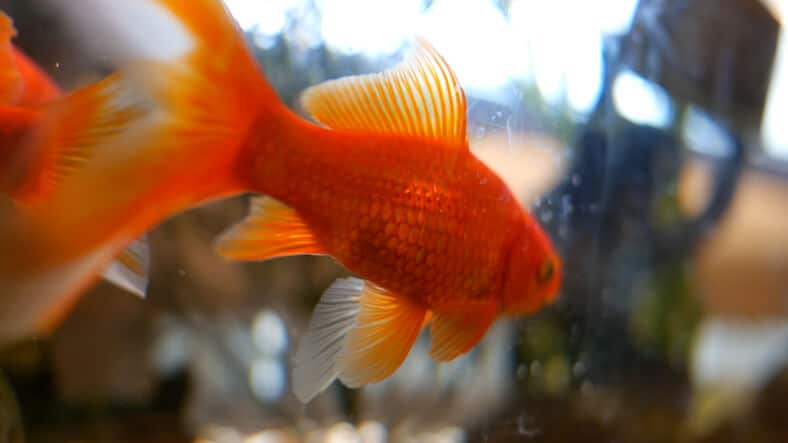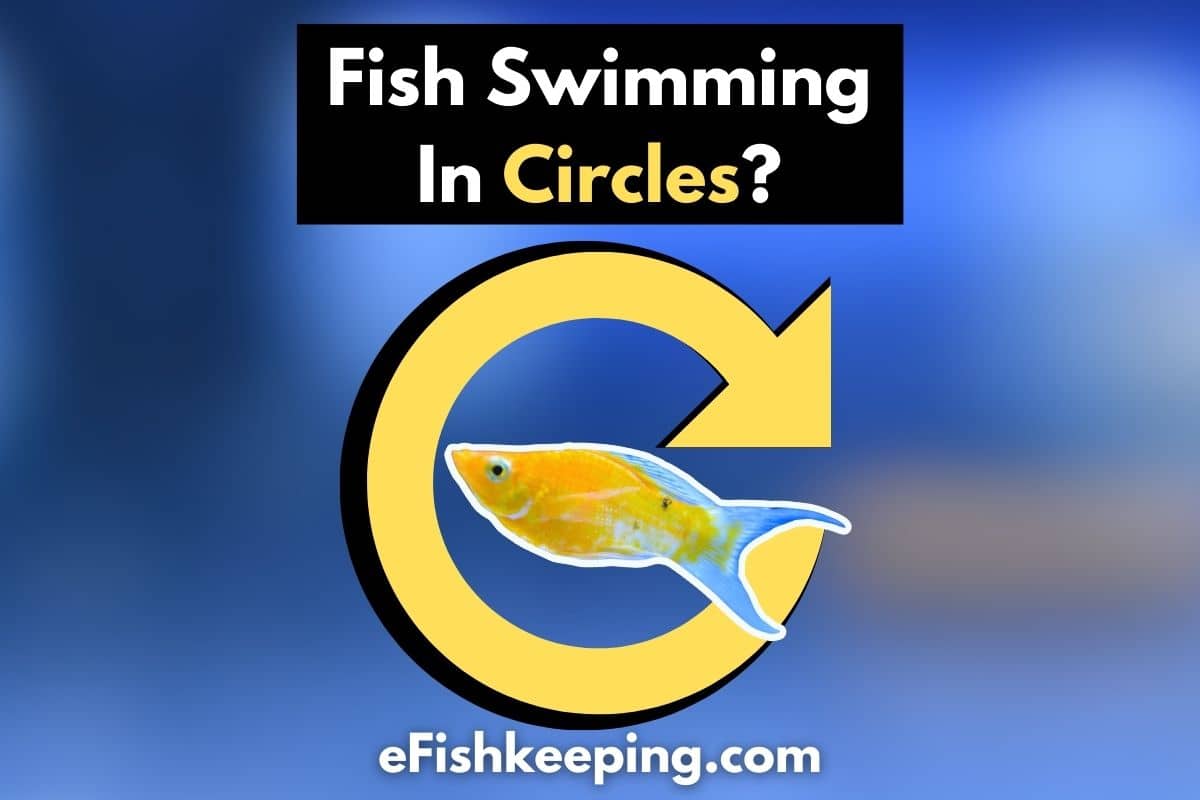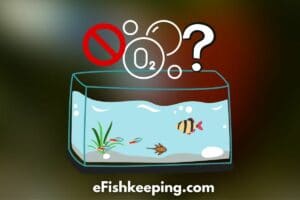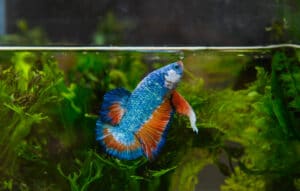Is your fish swimming erratically in circles? Then this is exactly the right place for you.
In this article, I will share with you the top 5 reasons why your fish swims in a circle. So read on to get a complete and clear understanding of this topic.
Here’s Why Your Fish Is Swimming In Circles:
Fish swim in circles if they suffer from the whirling disease, ammonia poisoning, swim bladder disorder, or stress. However, if the tank conditions are good and the fish is healthy, then it is likely that the fish is swimming in circles just for fun.

Let’s one by one discuss all the possible reasons why fish swim in circles:
#1. Fish suffering from Whirling Disease
Is your fish swimming in a very erratic way and in circular motions, despite your tank ammonia conditions being normal? Then the most likely reason is that your fish is suffering from a whirling disease caused by the myxozoan parasite Myxobolus cerebralis.
This infection is commonly found in fish that belong to the salmonid family. In this disease, the parasite enters into the body parts of the fish like the head and spinal cartilage. There, this parasite quickly multiplies and puts pressure on the organ of equilibrium of the fish.
As a result, the fish swims erratically (whirls) and finds it difficult to feed and avoid predators.
Essentially, this whirling disease parasite has two hosts:
- 1) The fish itself
- 2) A freshwater oligochaete worm, also known as the Tubifex tubifex
So if you are feeding Tubifex tubifex worms to your fish, then be careful!
And even if you don’t feed them, there are chances your fish might have already been exposed to them. How? Well, these Tubifex tubifex worms are sadly one of the common cheap-protein sources in many farms, mainly those selling to the discounters.
Some of the physical signs of this disease include:
- Twisted Spine
- Darkened Tail
- Deformed Head
In severe cases of infection, the whirling disease can also lead to death. And unfortunately, there is no cure for fish infected with this disease.
This whirling disease received its name primarily because of the radial tail-chasing swimming behavior of the heavily (and often fatally) infected fish.
Key Point: The chances of getting infected with the Myxobolus cerebralis is much more common for new fish, especially those fish that come from the discounters that sell fish from fish farms using ponds or Tubiflex worms as a cheap protein source.
It is important to note here that symptoms necessarily don’t always appear. And even if they occur, they are not the confirmation of diagnosis Myxobolus cerebralis. Generally, the microscopic slides can only confirm.
The fish infected with this disease will “whirl” in the forward direction in an awkward, corkscrew pattern instead of its normal swimming behavior. However, this behavioral change generally takes about 35-80 days after the initial infection.
Hence, if you have a fish in your aquarium, let’s say for about six months, and it is kept at 80°F (27°C), then the chances are that the fish doesn’t have the whirling disease.
#2. Fish suffering from Ammonia Poisoning
If your fish is continuously swimming in circles, specifically in a rapid motion, then it could be a sign of ammonia poisoning in your fish. In simple words, ammonia poisoning happens when ammonia and nitrite get built up in your aquarium.
Ammonia is basically a by-product of the rotting fish food and the fish waste in your aquarium. Ammonia poisoning can happen either suddenly or over a few days.
Some of the causes of ammonia poisoning are:
- Adding too many fish at one time in an established tank
- Filter failure due to power or mechanical failure
- Death of bacterial colonies due to the usage of medications
And as the ammonia poisoning continues in your tank, it can eventually impact and damage the organs, brain, as well as central nervous system of your fish. You might find your fish begin to get hemorrhage, internally and externally, and ultimately it might die.
Some of the symptoms of ammonia poisoning include:
- Lethargy
- Appetite Loss
- Gasping For Breath
- Bloody Patches On The Body
- Laying At The Bottom Part Of The Tank
- Red or Purple Gills
So it is very important to keep a check on the ammonia levels in your aquarium.
Treatment: As an immediate step, you can stop feeding your fish and thus ensure that no extra ammonia build-up occurs in your aquarium. And then, you can perform small and frequent water changes; along with that, you can aerate your aquarium with an air pump.
Don’t forget to test the aquarium water frequently to check the ammonia levels. Generally, you should aim to keep your aquarium nitrites and ammonia level at or near 0 ppm. And after all these, you can again start to feed your fish.
#3. Fish suffering from Swim Bladder Disorder

Bony fish have a specialized gas-filled internal organ called a swim bladder.
Swim bladder disorder means the condition in which the swim bladder organ of the fish doesn’t function properly (as it should) due to factors like physical abnormalities, diseases, mechanical or environmental factors, or maybe due to other reasons that can’t be diagnosed.
The main job of a swim bladder is to maintain the fish’s buoyancy.
When a swim bladder disorder occurs, the swim bladder organ doesn’t work properly. And as a result, the fish will start showing problems related to buoyancy, and it will struggle to control its floating or sinking ability.
Some of the symptoms of swim bladder disorders are: Floating to the top part of the tank, Struggling to stay upright, Curved Back, Sinking to the bottom part of the tank, and Change in appetite.
Although the swim bladder disorder is commonly seen in bettas and goldfish, there are chances that they can affect any species of fish. The good thing is that often you can treat this disorder, and you can fully recover your fish.
Treatment: Here are some tips that can help you treat your fish if it is suffering from swim bladder disorder.
- As a general rule, the first thing you can do if you notice swim bladder disorder in your fish is let it fast for roughly three days.
- Meanwhile, you can increase the water temperature to be about 78-80 degrees Fahrenheit and keep that condition during the treatment period.
- When the fourth day comes, you can start feeding your fish cooked and skinned pea. You can remove the skin of the peas before serving them to your fish. And you can continue this pea-feeding diet for a few days, and then you can switch to the specific diet of your fish depending on its species. However, you should still avoid pellets or flakes that float.
- If you feel that the cause of swim bladder disorder in your fish is some infection, then you can also treat them with broad-spectrum antibiotics. For exact medical-related recommendations, you might find it helpful to visit your veterinarian.
#4. Fish Is suffering from Stress
Strange swimming patterns are also one of the signs that show your fish is stressed. Often when fish are stressed, they show odd swimming patterns. Some of the reasons why stress occurs in fish are as follows:
#1. Inappropriate Water Conditions:
Poor tank water maintenance can be one of the causes of stress in your aquarium fish. Therefore, you should often conduct tests to check the water parameters whenever something wrong happens in your tank (for instance, when your fish are gasping at the surface).
High ammonia/nitrite levels, improper temperature, improper pH level, low oxygen level, all these can lead to stress in your fish. If you have a saltwater tank, inappropriate salt levels can also have a similar impact.
#2. Problems Because of Other Fish:
Having a bad tank mate combination for your fish or stocking the aquarium with too many fish, both can have a bad impact on your fish. Remember, fish do feel cramped if they are kept with too many fish or with the wrong fish.
If the tank mate of your fish is not compatible, then fights will often occur between them. Also, if you don’t have any hiding spots in your tank, then your fish can’t hide from the aggressive fish.
Plus, having too many fish may also lead to competition in the fish tank while your feed your fish.
#3. Presence of Chemicals
Apart from all the factors discussed earlier, stress can also occur because of the addition of any chemicals or medication added to the tank. If your fish is sick and suffering from any illness, you might find some medication helpful for curing that specific disease.
But it is important to note that such medications may also change the specific aspects of the water chemistry of your tank. So usually, whenever you treat a sick fish, ensure that you quarantine it first.
#4. Improper Diet
It is also important to be aware of the proper diet requirement of your fish and stick with it. Improper diet can also cause stress.
Solution: If your fish is suffering from stress, then the first step is to identify the root cause. I have already shared with you some of the possible causes of stress. And once you figure it, you can one by one eliminate those stress causes and thus make your fish happy and healthy.
#5. For Fun
Fish can be playful at times. Yes, really! As per a new study, it has been found that some species of fish can play to have fun just like other animals.
They often look for food here and there in the aquarium. They like to roam around, hide, and explore new places in your aquarium. In the whole process of roaming around the aquarium, they may sometimes circle for fun.
And, if you have kept your fish in a round-shaped tank like a round fishbowl, then it is possible that it is just swimming around in circles, imitating the round surface of the tank. This behavior should be considered normal and nothing to worry about.
Conclusion
In short, if your fish is swimming in circles, the most likely reasons can be whirling disease, ammonia poisoning, swim bladder disease, or stress. And if the fish is suffering from no disease and the fish tank environment is totally fine for the fish, then it may also be doing it just for fun.
I hope you got a clear idea of why fish swim in a circular pattern. Please share this article if you found it helpful. Thanks, and I hope your fish becomes healthy and active soon. Best of luck!
Recommended Reading:
Hi! I’m Praveen Ghoshal, the founder of eFishkeeping.com. Inspired by my Dad, I got interested in fishkeeping when I was a kid. Since then, I have been involved with this hobby. Currently, I have 3 fish tanks at our home, and I enjoy this hobby with my full family. Read more about me here.








